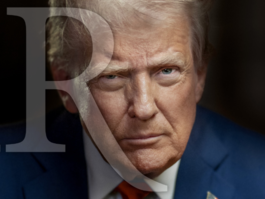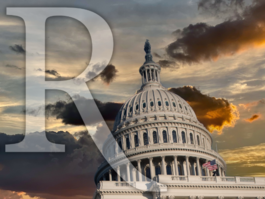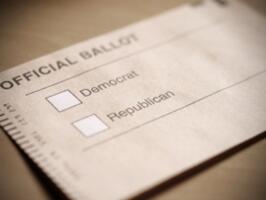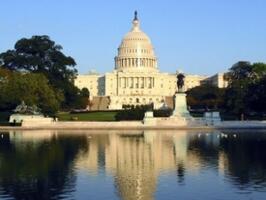51% Favor Government Shutdown Until Congress Cuts Health Care Funding
President Obama yesterday criticized congressional Republicans for insisting on spending cuts in any budget deal that continues government operations past October 1, saying they risk "economic chaos." Most voters agree a federal government shutdown would be bad for the economy, but they're willing to risk one until Democrats and Republicans in Congress agree on ways to cut the budget, including cuts in funding for the new national health care law.
Just 20% of Likely U.S. Voters believe a partial shutdown of the federal government would be good for economy, according to a new Rasmussen Reports national telephone survey. Fifty-six percent (56%) say such a shutdown would be bad for the economy, even though payments for things like Social Security, Medicare and unemployment would continue. Sixteen percent (16%) think it would have no impact. (To see survey question wording, click here.)
But 58% favor a federal budget that cuts spending, while only 16% prefer one that increases spending. Twenty-one percent (21%) support a budget that keeps spending levels about the same.
This helps explain why 53% would rather have a partial government shutdown until Democrats and Republicans can agree on what spending to cut. Thirty-seven percent (37%) would prefer instead that Congress avoid a shutdown by authorizing spending at existing levels as the president has proposed.
Some conservative Republicans in both the House and Senate are refusing to approve a budget unless it slows or stops funding for the health care law, but the president and most congressional Democrats are adamantly opposed to any such cuts. However, 51% of voters favor having a partial government shutdown until Democrats and Republicans agree on what spending for the health care law to cut. Forty percent (40%) would rather avoid a government shutdown by authorizing spending for the health care law at existing levels.
Late last month, 42% of Republicans said threatening to vote against a government funding bill unless it cuts off funds for the health care law will help the GOP. Twenty-eight percent (28%) disagreed, while 14% said it would have no impact. Fifty-two percent (52%) of Democrats and 48% of unaffiliateds thought it would hurt Republicans.
Most voters continue to dislike the health care law, and 54% expect it to increase, not reduce, health care costs. From the beginning of the debate over the law four years ago, voters have consistently said that cost is their number one health care concern.
Under the health care law, uninsured Americas are required to have health insurance by January 1, and failure to do so could result in sizable penalties. Now that the president has delayed implementation of the employer mandate portion of his new national health care law, 56% of voters think he also should delay the requirement that every American buy or obtain health insurance.
(Want a free daily e-mail update? If it's in the news, it's in our polls). Rasmussen Reports updates are also available on Twitter or Facebook.
The survey of 1,000 Likely Voters was conducted on September 14-15, 2013 by Rasmussen Reports. The margin of sampling error is +/- 3 percentage points with a 95% level of confidence. Field work for all Rasmussen Reports surveys is conducted by Pulse Opinion Research, LLC. See methodology.
The president sounded similar dire economic warnings before the so-called sequester automatic budget cuts kicked in March 1, but even after some highly publicized flight delays that were blamed on the sequester, just 24% of voters felt government spending was cut too much. Forty-four percent (44%) said spending wasn't cut enough. Now, interestingly, the president is proposing continuing federal spending at least in the short term at the lower levels set by the sequester.
Fifty-six percent (56%) of Americans think that when government agencies are forced to cut their budgets, they generally cut popular programs first to make the cuts seem more significant.
Democrats are far more concerned about the prospects of a government shutdown than Republicans and unaffiliated voters are. Seventy-nine percent (79%) of voters in the president's party think a partial shutdown would be bad for the economy, but just 40% of GOP voters and 48% of those not affiliated with either of the major parties agree. But then 78% of Republicans and 64% of unaffiliateds favor a federal budget that cuts spending, a view shared by just 34% of Democrats.
Sixty-three percent (63%) of Democrats agree with the president and would prefer to avoid a shutdown by authorizing spending at existing levels. Seventy-four percent (74%) of Republicans and 62% of unaffiliated voters would rather have a shutdown until the two sides can agree on what spending to cut.
Similarly, 78% of GOP voters and 57% of unaffiliateds like the idea of a partial shutdown until Democrats and Republicans can agree on what spending for the health care law can be cut. Sixty-nine percent (69%) of Democrats favor instead avoiding a shutdown by authorizing spending for the law at existing levels.
Looking to the future, 80% of GOP voters believe it is more important for their party to stand for what it believes in rather than to work with the president. Right now, 65% of Likely Republican Voters think Republicans in Congress have lost touch with GOP voters from throughout the nation over the last several years, while 59% of Likely Democratic Voters think Democrats in Congress have done a good job of representing their party's values.
The president and congressional Democrats have tied many of their criticisms of the Republican budget positions to the Tea Party. Just 39% of all voters now have a favorable opinion of the Tea Party, although 78% of Republicans believe it’s at least somewhat important for their leaders in Congress to work with the Tea Party, including 45% who think it’s Very Important.
While voters are more critical of the Tea Party itself, most continue to agree with its small government principles. Sixty-four percent (64%) prefer a smaller government with fewer services and lower taxes over a larger one with more services and higher taxes. Sixty-two percent (62%) think the government should cut spending rather than increase it in reaction to the nation’s economic problems.
Seventy-seven percent (77%) of all likely voters say they have been following recent news stories about the federal budget debate in Congress, with 42% who say they are following Very Closely.
Additional information from this survey and a full demographic breakdown are available to Platinum Members only.
Please sign up for the Rasmussen Reports daily e-mail update (it’s free) or follow us on Twitter or Facebook. Let us keep you up to date with the latest public opinion news.
The survey of 1,000 Likely Voters was conducted on September 14-15, 2013 by Rasmussen Reports. The margin of sampling error is +/- 3 percentage points with a 95% level of confidence. Field work for all Rasmussen Reports surveys is conducted by Pulse Opinion Research, LLC. See methodology.
Rasmussen Reports is a media company specializing in the collection, publication and distribution of public opinion information.
We conduct public opinion polls on a variety of topics to inform our audience on events in the news and other topics of interest. To ensure editorial control and independence, we pay for the polls ourselves and generate revenue through the sale of subscriptions, sponsorships, and advertising. Nightly polling on politics, business and lifestyle topics provides the content to update the Rasmussen Reports web site many times each day. If it's in the news, it's in our polls. Additionally, the data drives a daily update newsletter and various media outlets across the country.
Some information, including the Rasmussen Reports daily Presidential Tracking Poll and commentaries are available for free to the general public. Subscriptions are available for $4.95 a month or 34.95 a year that provide subscribers with exclusive access to more than 20 stories per week on upcoming elections, consumer confidence, and issues that affect us all. For those who are really into the numbers, Platinum Members can review demographic crosstabs and a full history of our data.
To learn more about our methodology, click here.






